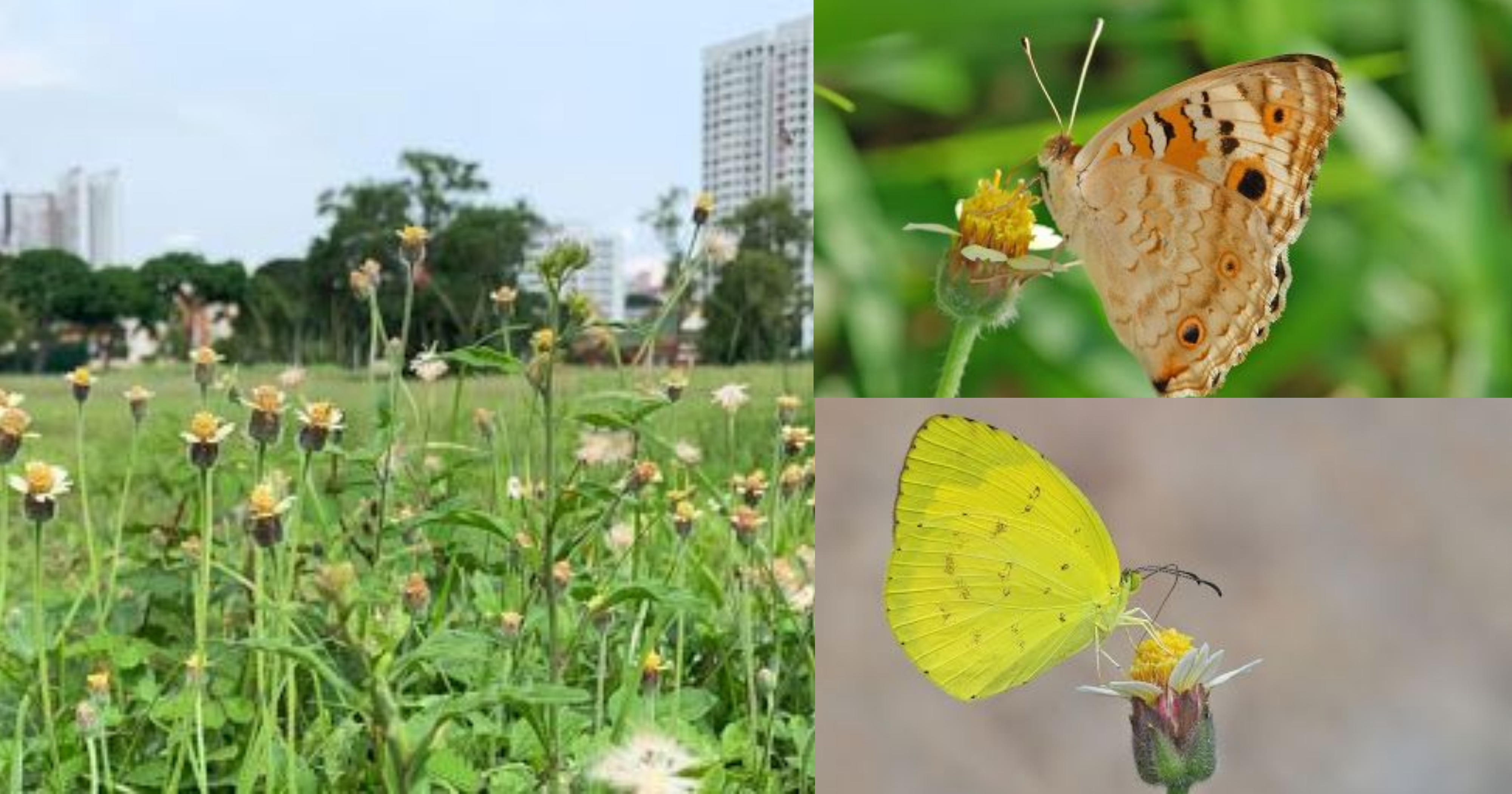COMMENTARY: Could grass cutting and pruning in some parts of Singapore be reduced to allow more biodiversity to thrive?
SK Khew writes about how he has observed how butterflies and other native insects returning to the urban areas thanks to the blooming wildflowers:
- Due to public health concerns shared by government agencies, it is understandable that trimming of wild grass has to resume as circuit breaker measures ease.
- However, these wild plants play an important role to support the biodiversity in Singapore.
- Allowing more wild plants to grow will bring us a step closer to becoming a City in Nature.
About the author: Khew is an avid butterfly enthusiast who has been blogging about butterflies in Singapore weekly for almost 13 years.
By SK Khew
It is hard to read any news portal or watch a TV broadcast today and avoid the dreaded C-word.
The pandemic is a global phenomenon, and I cannot imagine that anyone in the world has not heard of Covid-19 or the coronavirus, unless he or she has been hiding in some cave for the past six months.
This is an unprecedented moment in history where the entire world is facing the same 'storm' that has affected lives and livelihoods.
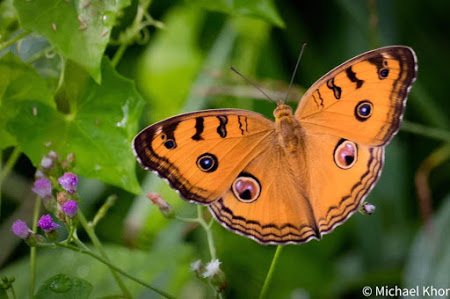 A Peacock Pansy feeding on the flowers of the Common Vernonia (Cyanthillium cinereum) an urban weed. Photo courtesy of Michael Khor.
A Peacock Pansy feeding on the flowers of the Common Vernonia (Cyanthillium cinereum) an urban weed. Photo courtesy of Michael Khor.
Wildflowers have flourished during Circuit Breaker
Over here in Singapore, we have come to the end of our "circuit breaker" or our version of a modified national lock-down that started nearly two months ago.
As the residents look forward to a more normal life, the authorities have announced that any changes will not be abrupt and things will have to take a cautious stepped approach as the economy is resuscitated.
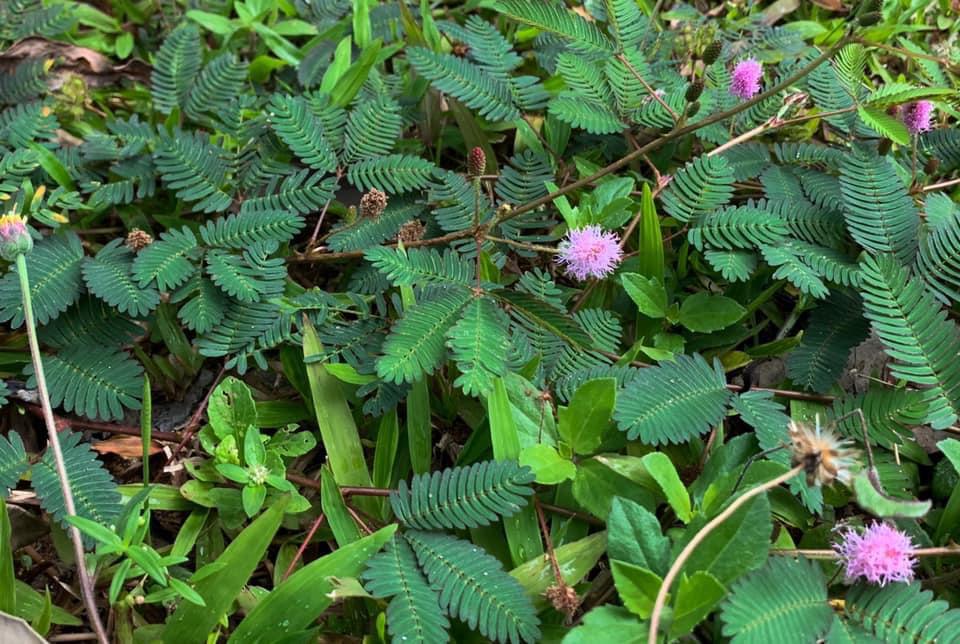 Photo courtesy of Jacob Tan.
Photo courtesy of Jacob Tan.
So, what has the Covid-19, a circuit-breaker, wildflowers and butterflies have in common?
Observant residents have noticed that Singapore's manicured roadside verges and grassy patches are overgrown with "weeds" and pretty wildflowers.
This is a result of the lockdown and reduction of non-essential activities like cutting grass, plus the reduction of the availability of the migrant worker population due to a sudden rise in COVID-19 infections amongst these workers who live in their assigned dormitories all around the island.
The appearance of wildflowers has attracted our urban insects like bees and butterflies to feed on them.
Increased sighting of butterflies
In recent weeks, there was an increase in sightings of urban species of butterflies amongst these temporarily unkempt greenery.
Taking a quick look around my housing estate where I have my daily exercise routine, it was indeed the case, as the nectar-laden wildflowers offered a delectable buffet to our winged friends.
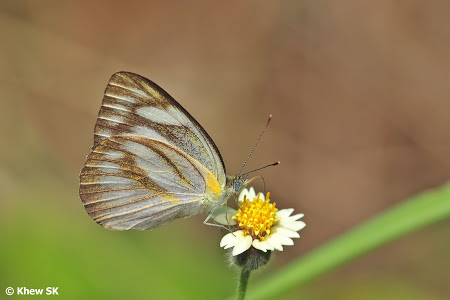 A female Striped Albatross was also observed in numbers over the past two months, usually feeding on the flowers of the Coat Button. Photo courtesy of SK Khew
A female Striped Albatross was also observed in numbers over the past two months, usually feeding on the flowers of the Coat Button. Photo courtesy of SK Khew
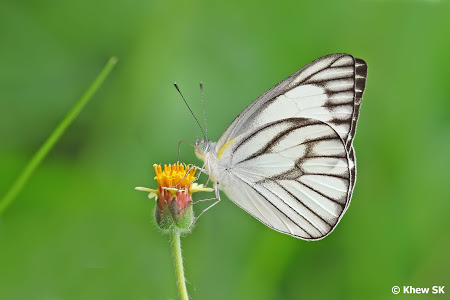 A male Striped Albatross. Photo courtesy of SK Khew
A male Striped Albatross. Photo courtesy of SK Khew
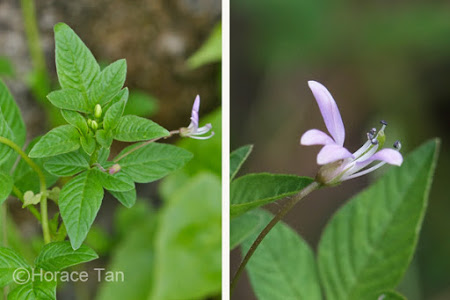 Their host plant, Purple Cleome (Cleome rutidosperma) also grows wild along roadside grass verges and open fields during the "circuit breaker" period. Photo courtesy of Horace Tan
Their host plant, Purple Cleome (Cleome rutidosperma) also grows wild along roadside grass verges and open fields during the "circuit breaker" period. Photo courtesy of Horace Tan
But what are these wildflowers and what butterfly species have been spotted across many urban areas across the island?
Taking a walk around my residential area and checking on social media and the snippets of commentaries from nature lovers and enthusiasts, the urbanscape's wildflowers are pretty limited to a handful of species. Here are the common ones you might come across:
- Coat Buttons (Tridax procumbens)
- Touch-Me-Not plant (Mimosa pudica)
- White Weed (Ageratum conyzoides)
- Common Vernonia (Cyanthillium cinereum)
- Cupid's Shaving Brush (Emilia sonchifolia)
- Purple Cleome (Cleome rutidosperma)
The explosion of these flowering weeds and nectaring sources has a trickle-down effect on butterflies, especially the urban species like the Striped Albatross (Appias olferna olferna), the Lesser Grass Blue (Zizina otis lampa), the Pygmy Grass Blue (Zizula hylax pygmea), the Blue Pansy (Junonia orithya wallacei), the Chocolate Pansy (Junonia hedonia ida), the Tawny Coster (Acraea terpsicore), the Common Grass Yellow (Eurema hecabe contubernalis).
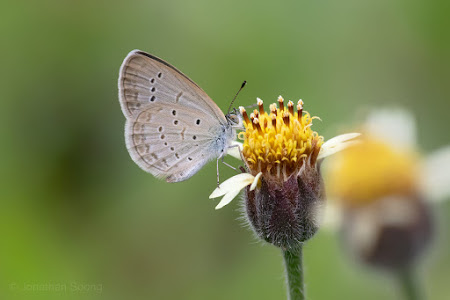 A Lesser Grass Blue feeding on the flower of the Coat Buttons. Photo courtesy of Jonathan Soong
A Lesser Grass Blue feeding on the flower of the Coat Buttons. Photo courtesy of Jonathan Soong
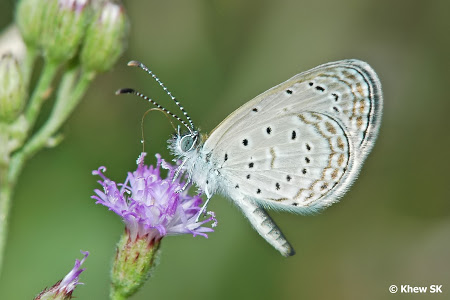 A Pygmy Grass Blue feeding on the flower of the Common Vernonia. Photo courtesy of SK Khew
A Pygmy Grass Blue feeding on the flower of the Common Vernonia. Photo courtesy of SK Khew
These butterflies are sighted more frequently over the past two months, feeding at the wildflowers in our urban residential estates.
The diminutive Lesser Grass Blue and its related Pygmy Grass Blue (Zizula hylax pygmea) can sometimes even be abundant, with 20 or more individuals fluttering amongst the wildflowers.
The same can be said of the Striped Albatross (Appias olferna olferna) which is more regularly seen in numbers over the past few weeks.
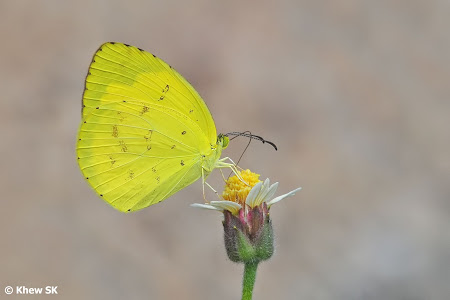 A Common Grass Yellow feeding on the flower of the Coat Buttons. Photo courtesy of SK Khew
A Common Grass Yellow feeding on the flower of the Coat Buttons. Photo courtesy of SK Khew
Debates on whether areas should be left "wild"
The blooming of these wildflowers and areas which were left unmaintained by landscaping contractors and the town councils sparked off some debates as to whether there should be areas which could be left "wild" for the biodiversity to thrive.
Comments that there is "beauty" in these wildflower meadows that add a different perspective to our urban greenery, are counterbalanced with opposing views that these unkempt areas may attract snakes, mosquitoes and other undesirable vermin.
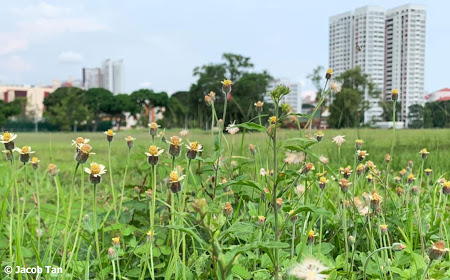 A field of wild-growing Coat Buttons with residential apartments in the background. Photo courtesy of Jacob Tan
A field of wild-growing Coat Buttons with residential apartments in the background. Photo courtesy of Jacob Tan
However, government agencies in charge of the maintenance of our landscaped greenery across the island have indicated that "operations include preventive tree pruning and landscape works such as grass cutting for vector control, and the prevention of vegetation fires in parks and gardens. Grass cutting is also carried out on road verges."
It would logically be assumed that any grass cutting would obviously take out these wildflower "weeds" as well.
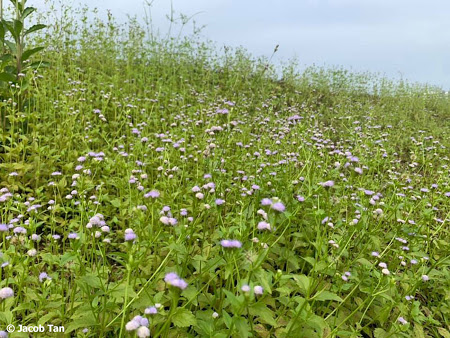 An open field of White Weed (Ageratum conyzoides) growing in abundance with no grass cutters in sight over the past two months. Photo courtesy of Jacob Tan
An open field of White Weed (Ageratum conyzoides) growing in abundance with no grass cutters in sight over the past two months. Photo courtesy of Jacob Tan
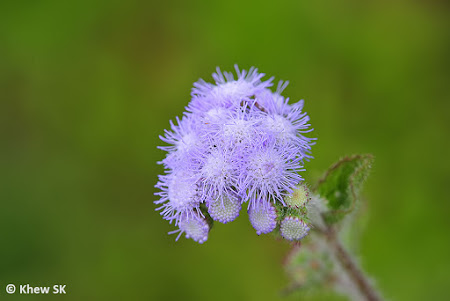 A close-up shot of White Weed. Photo courtesy of SK Khew
A close-up shot of White Weed. Photo courtesy of SK Khew
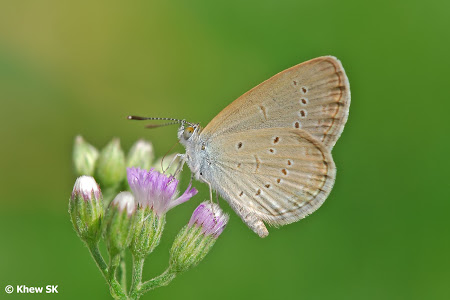 A Lesser Grass Blue feeding on the flower of the Common Vernonia. Photo courtesy of SK Khew
A Lesser Grass Blue feeding on the flower of the Common Vernonia. Photo courtesy of SK Khew
To further quote the article by the Straits Times:
"Assistant Professor John Ascher from the National University of Singapore's biological sciences department is among those in favour of the island's new rustic look, saying that "overzealous" removal of weeds may have led to low bee numbers at many managed sites in Singapore, including nature parks. Weeds are a food resource for bees, he said. 'I suppose I am in the minority to be happy if more weeds lead to more 'bugs', at least with respect to wild bees, butterflies, flower flies and other attractive or beneficial species,' added Prof Ascher."
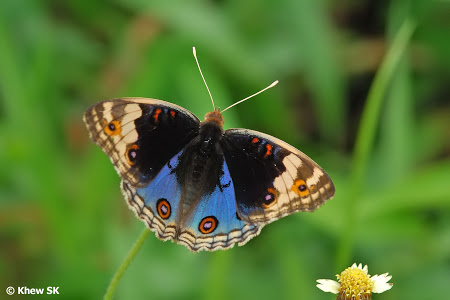 Photo courtesy of SK Khew.
Photo courtesy of SK Khew.
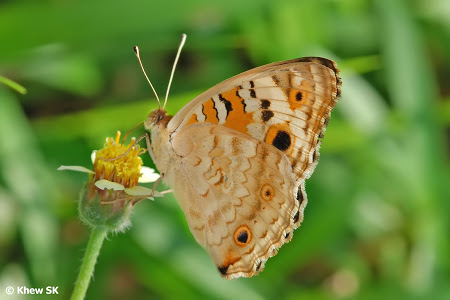 Blue Pansy feeding on the flower of the Coat Buttons. Photo courtesy of SK Khew.
Blue Pansy feeding on the flower of the Coat Buttons. Photo courtesy of SK Khew.
Can we change the way we manage our landscape greenery to allow biodiversity to thrive?
Butterfly conservationists will know that even if there are a lot of wildflowers, the ecosystem also needs to support adequate caterpillar host plants of these species.
Otherwise the number of butterflies will be limited by the availability of their host plants. Hence other "weeds" like Chinese Violet (for the Blue Pansy), Purple Cleome (for the Striped Albatross), Mimosa (for the Grass Blues), Stinking Passionflower (for the Tawny Coster) and so on, must be allowed to grow, to complement the wildflower nectaring sources.
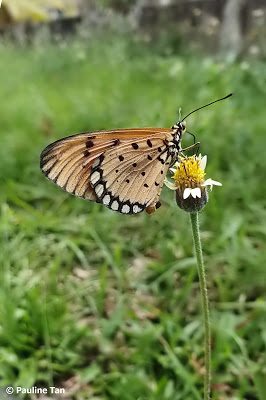 A Tawny Coster feeding on the flower of a Coat Buttons in an urban residential estate. Photo courtesy of Pauline Tan
A Tawny Coster feeding on the flower of a Coat Buttons in an urban residential estate. Photo courtesy of Pauline Tan
It is encouraging that we see so many butterflies out and about when these wildflowers provide nectar for them.
Other urban resident insects like bees, flies and others will also benefit.
Perhaps, in the management of our urban spaces, NParks could create "wild miles" or "wild squares" that are left to grow naturally with minimal grass-cutting and pruning?
These can complement the pristine and manicured areas so that there is a balance between biodiversity conservation and aesthetics/safety for human parks users.
Have an interesting perspective to share or a commentary to contribute? Write to us at [email protected].
Top image courtesy of SK Khew and Jacob Tan
If you like what you read, follow us on Facebook, Instagram, Twitter and Telegram to get the latest updates.
